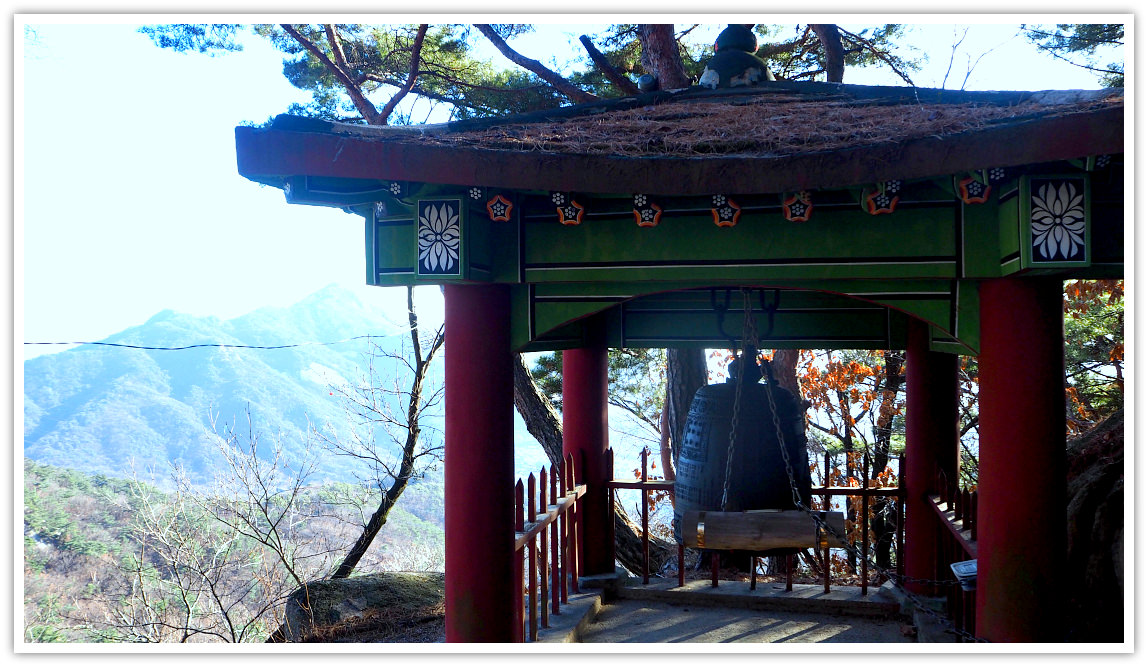Hidden Yongguram Temple
In Surak Mountain
 One of the temples of Yongguram when viewed from below the main entrance.
One of the temples of Yongguram when viewed from below the main entrance.Introduction
Embark on a spiritual journey through time at the Yongguram Temple, a sacred Buddhist sanctuary nestled on the serene slopes of Surak Mountain in South Korea.
Rooted in over a thousand years of history, Yongguram has endured as a testament to Korea's enduring Buddhist heritage and architectural artistry.
Built during the Unified Silla period in the 8th century, Yongguram holds a unique place in Korean Buddhism. Its name, translating to "Dragon Palace Hermitage," is believed to have been inspired by an ancient legend of a dragon residing in a cave nearby, guarding the mountain's spiritual energy.
The temple is renowned for its meditation cave, a sacred space intricately carved into the rocky mountainside. Within, the tranquility is palpable, offering an immersive experience of the monastic life. Visitors can find solace in the serene ambiance, surrounded by the ethereal sounds of nature.
Outside, the temple's architecture harmoniously blends with the natural landscape, adorned with elegant stone pagodas, statues, and vibrant dancheong decorations. Amidst the lush forests of Surak Mountain, Yongguram serves as a spiritual haven, radiating peace and harmony.
Yongguram Temple invites visitors on a transcendent journey, bridging the human realm with the spiritual, the present with the past, and art with nature.
suraksan's yongguram temple
Yongguram Temple is a ‘hidden temple’ located in the beautiful Surak Mountain, South Korea. It is known to be a hiding place for a short time of Empress Myeongseong in the late Joseon Period in 1882.
Yongguram is a small temple with much smaller religious facilities for Buddhism believers compared to its neighbor temple—Hangnimsa Temple.
However, Yongguram Temple has a wider and better view of the southern side of the area. You can have a panoramic and spectacular view of the sunset (if you consider this as your trail going back to the subway station).
This temple is about fifteen minutes from Hangnimsa Temple, a much bigger temple area with more to see (or meditate on!).
 Temple at Yongguram, Suraksan
Temple at Yongguram, Suraksan Daeungjeon Hall (means 'great' hall)
Daeungjeon Hall (means 'great' hall)some historical briefs
Yongguram was established in 1878, according to the descriptions at its entrance area. The monks started by performing their worship to Buddha while fasting inside the cave called Nahangul Cave.
This cave is now part of the main temple and located just beside it. This small temple became notable as it hid Empress Myeongseong for a while then escaped to Yeoju in 1882 due to the Imo Incident (壬午軍亂 임오군란), or known as the Imo Mutiny. It was a violent uprising in Seoul in 1882 by soldiers and later joined by wider Korean people. The event was partly due to Emperor Gojong’s reform and modernization activities.
Yongguram is also an Arhat Prayer Center, a place where one can become a ‘perfected person’ who gained enlightenment. In other words, this place is where you can achieve nirvana (spiritual enlightenment).
According to Buddhism, an arhat is considered to be the proper goal of a Buddhist in life. (Sounds interesting!)
At Nahangul Cave, you will find some Sakyamuni and Arhat statues. At the Daeungjeon Hall, you will see (when it is opened) a stone statue of seated Shakyamuni.
Even during the Korean War, Yongguram Hermitage continued as a center for practicing Buddhists. This was due to the efforts of the monks and people who were supporting the temple activities during trying times in history.
 Panorama of the south from the temple
Panorama of the south from the templeTraveling to Yongguram Temple
You can take a subway for Danggogae Station, Line 4 from any Seoul Subway system.
Then you should get out from Exit 4 and follow the signpost pointing Hangnimsa Temple. Once at Hangnimsa’s entrance area, proceed to the stone steps on the left leading to Yongguram Temple.
Don’t worry about getting lost as there are other hikers and signpost posted at strategic places.
 Bell of Yongguram as seen facing the south side of Surak Mountain
Bell of Yongguram as seen facing the south side of Surak Mountain Pass by this Buddha when proceeding towards Suraksan summit
Pass by this Buddha when proceeding towards Suraksan summitTrip Towards Suraksan Summit
From Yongguram, you can proceed to the peak of Surak Mountain if that’s your main destination. This trail is located near the bell (tower) which leads to the newly built Buddha statue. From this statue, it is about 1.5 kilometers to the summit.
In conclusion, Yongguram Temple in Surak Mountain is one of the most beautiful, unique temples in South Korea. Its setting within a mountain range offers stunning views and peaceful natural surroundings, making it an ideal destination for those seeking a spiritual experience.
The temple's long history and its intricate details also make it a fascinating place to explore. Visiting Yongguram Temple is sure to be an unforgettable adventure.
Whether you're a first-time visitor or one of many returnees, the temple's beauty and its significance in South Korean culture will surely leave you with an appreciation of this special place.
Thanks for visiting this page. Have an amazing journey!
- Home
- Temples in South Korea
- Yongguram Temple in Surak Mountain
Get Exciting Activities
Book one of our exciting activities today to experience the thrill of a lifetime! Take advantage of this opportunity and secure your spot in advance.
Hotel Map Guide
Find your affordable, accessible, and comfortable hotel in Seoul at Agoda.Com. See the hotel map below...
Hotel Booking Guide
Find affordable and amazing hotels on Agoda.com using the search box below. Book now to enjoy great discounts and save!







New! Comments
What do you think about this page? Leave me a comment in the box below.